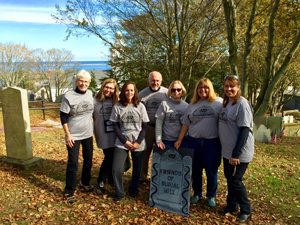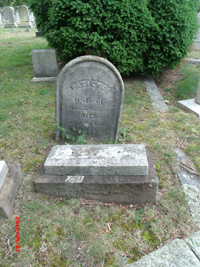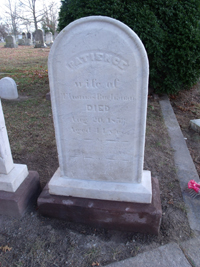Cheryle Caputo, Cemetery Preservationist/Gravestone Conservator

From left, FOBH co-founders June Gillette,
Cheryle Caputo, and members Rhonda Atchison,
Don Dewey, Kathy Harrington, Cynthia Snow and
Donna Shea
Cheryle Caputo is a Cemetery Preservationist/Gravestone Conservator with expertise in repairing historic gravestones. She presently serves as president and director of the Friends of Burial Hill (FOBH), Chair for the Association for Gravestone Studies Southeastern New England and Cape Cod Chapter, and as president and lead conservator at Gravestone Conservation Services, Inc.
What led you to your field?
My grandparents, Frances and Manuel, would often have my sister and I, then young children, accompany them to the cemetery to tidy up the family gravesite on Sundays. The cemetery might have been part of a Sunday drive or a stop on the way for ice cream, but most often it was the destination. My grandparents would tend the graves of their beloved first born and equally as loved grandson. There were others too. My most vivid memory of these visits is of my grandmother using a corn broom to sweep leaves and such from around the graves. We had to remain close, but not too close, allowed to skip away and explore a bit. I am sure it was these visits that fostered my enjoyment of burial grounds. It was this appreciation that all too often brought me to my hometown favorite, Burial Hill. Burial Hill despite its historical significance, as an inactive burial ground, it was allowed to deteriorate and suffer from disinterest and municipal neglect. I often wondered why nothing was being done. Serendipity in the form of our mutual friend Gretchen, brought June Gillette and I together to found the Friends of Burial Hill, a 501(c) (3) with a mission to preserve, protect, and promote Burial Hill. We obtained training which helped us to properly clean gravestones. I wanted to learn more. Over the next couple of years I sought additional training in all aspects of gravestone conservation, attending numerous conferences, workshops, product training sessions, seminars as well as hands on training with professionals. I am fortunate to be among those who work at this craft.
How does what you do relate to historic preservation?
 I work to preserve cemeteries and burial grounds, and in the process conserve grave markers, memorials, and monuments, many of which are several centuries old. Without conservation these stones would certainly continue to deteriorate hastened by modern problems such as pollution and acid rain exacerbating their precarious situation. I view them as artifacts. Of interest, culturally, historically, and artistically.
I work to preserve cemeteries and burial grounds, and in the process conserve grave markers, memorials, and monuments, many of which are several centuries old. Without conservation these stones would certainly continue to deteriorate hastened by modern problems such as pollution and acid rain exacerbating their precarious situation. I view them as artifacts. Of interest, culturally, historically, and artistically.
Why do you think historic preservation matters?
What would our world be without the sense of place that history provides? It helps us to understand who we are and how we got here. In my field, much can be gleaned from the information and iconography carved into the face of a piece of slate or marble such as customs, views on the afterlife, societal patterns, trends, and status. Understand that for some, this is the only written record of their existence.
What courses do you recommend for students interested in this field?
Historic preservation, archaeology, and a geology class or two. A working knowledge of ground penetrating radar and GIS has been helpful for me. I would also suggest developing good research and communication skills. Add the latest technology to your toolbox-thermal imaging, laser mapping, and photogrammetry. Attend seminars, conferences, workshops and if you are able, apprentice for a time.
Do you have a favorite preservation project? What about it made it special?
I don’t believe I can point to a favorite preservation project. Everything I have worked on, either with the Friends of Burial Hill or on my own, one stone or an entire cemetery, has had meaning for me. I remember the very first stone I cleaned. The actual hands on work of conserving a gravestone can be a moving experience. An FOBH project that we are working on right now is rather special to me. We are in the process of learning through the aid of ground penetrating radar (GPR) what we hope is the actual site of the mass grave containing the remains of more than 60 seamen of the Brigantine General Arnold which ran aground in the harbor off Plymouth in December of 1778. A monument to these men marks a spot, but our investigation has shown that it is not the place of burial. We are hoping to soon make a determination of the area we believe to be the grave and mark the site appropriately.
Can you tell us what you are working on right now?
 FOBH is currently building a database of surveys that volunteers have recorded of each marker on Burial Hill as to stone conditions, material, iconography, treatments and more. Often extensive genealogical research on the person interred is included. A digital photographic record of present conditions accompanies each survey. Not only is this a most comprehensive record, it also allows us to track the longevity of treatments and plan for additional gravestone cleanings. The group is also actively conserving markers, offering training workshops, educational programs, and tours.
FOBH is currently building a database of surveys that volunteers have recorded of each marker on Burial Hill as to stone conditions, material, iconography, treatments and more. Often extensive genealogical research on the person interred is included. A digital photographic record of present conditions accompanies each survey. Not only is this a most comprehensive record, it also allows us to track the longevity of treatments and plan for additional gravestone cleanings. The group is also actively conserving markers, offering training workshops, educational programs, and tours.
How do you think the national historic preservation programs help your community?
Raises awareness, fosters collaboration and an appreciation for our cultural heritage, provides educational opportunities, and makes available funding in the form of Historic Tax Credits.
Do you have advice for novice preservationists?
Indeed I do. Whether working professionally or as a civic minded volunteer, learn all you can about your subject. Get to know your town officials, don’t hesitate to seek the advice of experts and don’t be deterred from your mission.
How does stewardship play a role in historic preservation?
Without the people and organizations that care deeply about the historic fabric of our landscapes, structures, waterways, and artifacts, they would disappear from our lives. Historically, we know this to be true. All too often we wonder, “Whatever happened to the...”, “Didn’t there used to be a ...,” or “What was here before CVS?”
As a Preserve America Steward (one of only 58 nationwide) the Friends of Burial Hill, an all-volunteer organization, feel privileged in helping to ensure that Burial Hill remains the historic gem that it is today, not only in reversing decades of neglect, but also routinely incorporating preventative measures to combat the ravages of time.
Read more Q&A stories about the preservationists in your neighborhood!